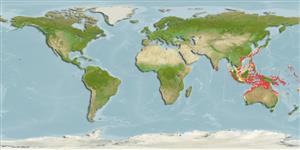Common names from other countries
>
Eupercaria/misc (Various families in series Eupercaria) >
Labridae (Wrasses) > Bodianinae
Etymology: Choerodon: Greek, choiros = a pig + odous = teeth (Ref. 45335); referrring to the prominent anterior canines of the species in this genus (Ref. 116605); zamboangae: Named for its type locality, Zamboanga, southern Philippines..
More on authors: Seale & Bean.
Environment: milieu / climate zone / depth range / distribution range
นิเวศวิทยา
เกี่ยวกับทะเล,น้ำเค็ม เกี่ยวกับหินโสโครก; ระดับความลึก 25 - 60 m (Ref. 90102). Tropical
Indo-West Pacific: Philippines (Ref. 9710) to Indonesia and northwestern Australia. Possibly the male of Choerodon robustus (Ref. 9710).
ขนาด / น้ำหนัก / Age
Maturity: Lm ? range ? - ? cm
Max length : 45.0 cm TL เพศผู้/กระเทย; (Ref. 48636)
เงี่ยงครีบหลัง (รวม) : 13; ก้านครีบอ่อนที่หาง (รวม) : 7; เงี่ยงครีบก้น: 3; ก้านครีบอ่อนที่ก้น: 10. Body without a broad dark, pale-margined, oblique band on side; body bicoloured, dusky anterodorsally and pale posteroventrally, line of demarcation extending between base of first dorsal-fin spine and upper side of pectoral-fin base; a broad anteroventrally tapering reddish brown stripe covering dorsal half of side posterior to greenish brown anterodorsal portion of body; reddish brown area edged ventrally by yellow stripe. (Ref 9823)
Found on deep outer reef habitats; flat sandy or weedy areas. Rarely seen by diving and is usually caught on lines from deep water (Ref. 48636). Usually found solitary, in rubble bottoms near seaward reefs. C. melanostigma is a junior synonym (Ref. 90102).
Life cycle and mating behavior
Maturities | การสืบพันธุ์ | Spawnings | Egg(s) | Fecundities | ตัวอ่อน
Oviparous, distinct pairing during breeding (Ref. 205).
Sainsbury, K.J., P.J. Kailola and G.G. Leyland, 1985. Continental shelf fishes of the northern and north-western Australia. An illustrated guide. CSIRO Division of Fisheries Research; Clouston & Hall and Peter Pownall Fisheries Information Service, Canberra, Australia. 375 p. (Ref. 3131)
IUCN Red List Status (Ref. 130435)
CITES (Ref. 128078)
Not Evaluated
Threat to humans
Harmless
Human uses
เครื่องมือ
Special reports
Download XML
แหล่งที่มาจากอินเตอร์เน็ต
Estimates based on models
Preferred temperature (Ref.
115969): 24.2 - 28.4, mean 27.2 (based on 101 cells).
Phylogenetic diversity index (Ref.
82804): PD
50 = 0.5000 [Uniqueness, from 0.5 = low to 2.0 = high].
Bayesian length-weight: a=0.01318 (0.00582 - 0.02984), b=3.05 (2.86 - 3.24), in cm Total Length, based on LWR estimates for this (Sub)family-body shape (Ref.
93245).
ระดับชั้นอาหาร (Ref.
69278): 3.5 ±0.4 se; based on size and trophs of closest relatives
ความสามารถในการกลับคืนสู่ปกติ (Ref.
120179): ขนาดกลาง, เวลาต่ำสุดที่จะทำให้ประชากรเพิ่มขึ้นเป็น 2 เท่าใช้เวลา 1.4 - 4.4 ปี (Preliminary K or Fecundity.).
Fishing Vulnerability (Ref.
59153): Low to moderate vulnerability (35 of 100).
